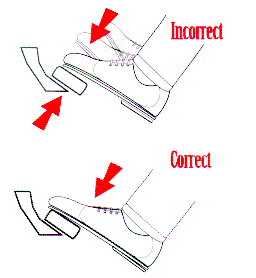|
How do I use ABS?
Apply
steady and constant pressure - do not take
your foot off the brake pedal until the
vehicle has stopped and do not pump the
brake.
|
 |
Top
What is that noise and vibration?
This is normal and
indicates that the ABS is active. Various ABS sound or
feel differently. Some of the effects, for example are:
- a
groaning noise
- a rapid
pulsing of the brake pedal
- a
periodic dropping of the brake pedal
- a hard
(non compliant) brake pedal
- a light
that turns on to say "low
traction".
You should
familiarize yourself with how your system functions by
first reading the "Owner’s Manual" and
then testing your ABS in an empty parking lot under
various climatic conditions i.e. dry, wet, snow and ice.
 |
Brake pedal will pulsate
As
the ABS engages, you may feel the brake pedal
pulsating. This is caused by the system applying
and releasing pressure to the brakes. |
The
noise associated with ABS when it is functioning should
not be confused with brake squeal. If your brakes squeal
under normal braking, this may mean the brake pads are
worn and need replacing. A pulsing brake pedal every time
you apply the brakes may mean warped brake rotors and/or
seized brake calipers that require servicing.
REMEMBER...WHEN IN
DOUBT, CHECK IT OUT. Transport Canada recommends that if
you are experiencing any abnormal braking, have it
checked out at your dealer.
Top
Is the stopping distance shorter with ABS?
No! From early
commercials, it may have looked like you could stop on a
dime. That instantaneous stop is not realistic. When
braking on dry or wet roads your stopping distance will
be about the same as with conventional brakes.
You should allow
for a longer stopping distance with ABS than for
conventional brakes when driving on gravel, slush, and
snow. This is because the rotating tire will stay on top
of this low traction road surface covering, and
effectively "float" on this boundary layer.
A non ABS braked
vehicle can lock its tires and create a snow plow effect
in front of the tires which helps slow the vehicle. These
locked tires can often find more traction below this
boundary layer.
Top
Snow tires
Braking and
steering are limited by the amount of traction your tires
can generate. Testing has shown that good snow tires
reduce the stopping distance of an ABS equipped vehicle
in winter conditions.
Rather than
installing only two snow tires on the drive wheels, it is
RECOMMENDED that you install four snow tires to maintain
equal traction on each wheel. This will help you to
steer, stop, and accelerate.
|

